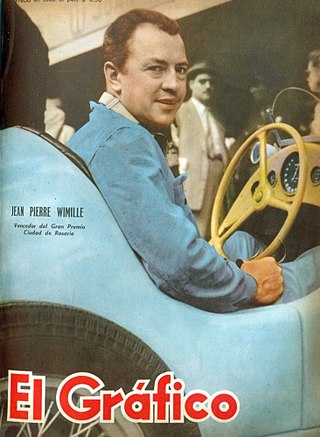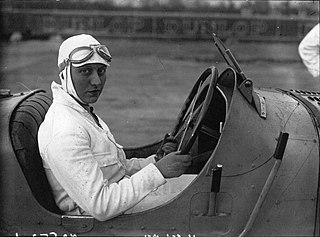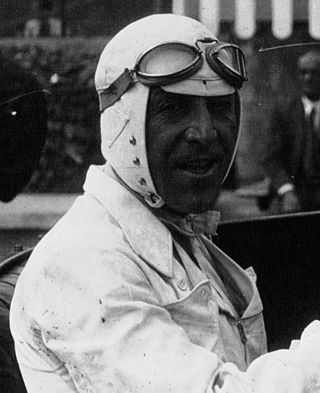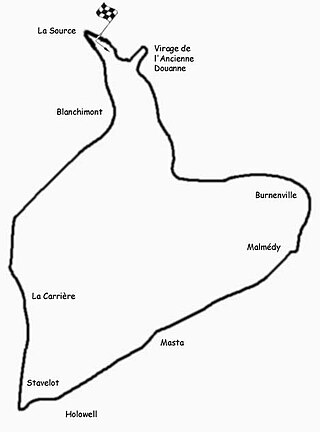
Jean-Pierre Wimille was a French racing driver and a member of the French Resistance during World War II. He was a two-time victor of the 24 Hours of Le Mans, winning in 1937 and 1939. He is generally regarded as one of the best French drivers of his era.

Mariette Hélène Delangle (1900–1984), better known by her stage name Hellé Nice, was a French dancer and motor racing driver. She danced in Paris at the Hôtel Ritz, Olympia Hall and Casino de Paris, before her career was ended by a skiing accident. She then became a racing driver, using roadster cars built by companies such as Alfa Romeo, Bugatti, DKW, Ford, Hispano-Suiza, Renault and Rosengart. She competed in various Grand Prix motor racing, hillclimbing and rally events at a time when it was rare for a woman to do so. She won the Grand Prix Féminin and the Actor's Championship in 1929. Already famous in Paris, she became a household name in France in the early 1930s and raced as an exhibition dirt track driver for a season in the United States.
The Grand Prix du Comminges was an automobile race held in France.

Philippe Jean Armand Étancelin was a French racing driver, and a winner of the 1934 24 Hours of Le Mans. He competed primarily on the Grand Prix circuit, and was an early Formula One driver.

The 1936 Grand Prix season was the third year of the 750 kg Formula. The next iteration of the Mercedes-Benz did not prove successful and the team withdrew during the season to instead prepare for the next one. It therefore fell to the resurgent Auto Union team to dominate the racing. In particular, it was their young, new superstar, Bernd Rosemeyer, who mastered the tricky car and who showed superlative skill in wet conditions. Rosemeyer easily won this season's European Championship by winning three of the four Grands Prix.

Guillaume Laurent "Guy" Moll was a French racing driver.

The 1935 Grand Prix season was the second year of the new 750 kg Formula. The success of the previous year encouraged the AIACR to reinitiate the European Championship. It was composed of the seven national Grands Prix and was won by Rudolf Caracciola, driving for the Mercedes-Benz team. The team dominated the season winning five of those Grand Épreuves, as well as four of the other major races of the season. However, in one of the great motor-races in sporting history, Tazio Nuvolari in a Scuderia Ferrari Alfa Romeo beat the combined numbers of the German teams in their home Grand Prix. The season also saw the arrival on the international stage of the bright young talent Bernd Rosemeyer in the Auto Union team.

The 1931 Grand Prix season was a watershed year, with the advent of the AIACR European Championship. After several years of Grand Prix racing in the doldrums with little technical development, 1931 saw new models come from all three main manufacturers: Bugatti, Maserati and Alfa Romeo.

The 1932 Grand Prix season marked the second year of the AIACR European Championship. It saw the debut of Alfa Romeo's sensational new Tipo B and with it, Tazio Nuvolari won the Championship driving for the Alfa Corse works team. The 40-year old Nuvolari won two of the three rounds and was second in the other. Still running to a Formula Libre rules for the cars, the regulations were revised to set the races to be between five and ten hours. However, all three national committees ran their races to the minimum time-limit.

The 1933 Grand Prix season was an intermediate year, as it would be the last season for the current AIACR regulations before a new weight-formula was introduced in 1934. As such, the European Championship was not held and the manufacturers held back on further developments of their existing models. Alfa Romeo, following an Italian government financial bailout and like Mercedes-Benz the previous year, had shut down its Alfa Corse works team. Scuderia Ferrari, their regular customer team took up the role of racing Alfa Romeos and a number of ex-works drivers moved across to join their ranks. They were not allowed, however, to buy the impressive Tipo B that had been so dominant in the previous season.
The 1934 Grand Prix season saw the advent of the new 750 kg Formula. In an effort to curb the danger of rising speeds, the AIACR imposed this upper weight limit that effectively outlawed the large capacity engines. The incumbent manufacturers Alfa Romeo, Maserati and Bugatti had been preparing their new models with varying success – the best of which was the Alfa Romeo Tipo B. However, it was the state-sponsored arrival of the two German teams, Mercedes-Benz and Auto Union, and their innovative and progressive cars that ignited a new, exciting era of motor racing.
The 1929 Grand Prix season was another interim year, where most races were run to Formula Libre rules due to a lack of regulations from the AIACR that would be popular for race organisers and manufacturers. This blurred the line between racing cars and sports cars with both competing in the same races. Bugatti won the major international races, with their drivers Louis Chiron and "W Williams". The Italian Championship proved very competitive, attracting many top drivers. There it was Alfa Romeo, using their 4-year old P2 model that claimed more victories, than their main competition coming from Bugatti and Maserati.
The 1930 Grand Prix season continued the malaise that had taken over the sport. Although there was little technical advance more privateer teams were forming, getting some factory support. The AIACR continued to mandate its fuel-regulated Formula Libre rules. Across the Atlantic, the AAA abandoned the AIACR regulations. Their new regulations were derisively called the “Junk Formula” by purists, opening up to their own version of Formula Libre: with modified stock-standard cars of up to 366 cu in (6-litres) with two seats.

Marcel Lehoux was a French racing driver and businessman.

The Tunis Grand Prix or Grand Prix de Tunis was a motor race held in the 1920s and 30s in Tunis, the capital of the African colony of the French protectorate of Tunisia.

The 1933 Belgian Grand Prix was a Grand Prix motor race held at Spa-Francorchamps on 9 July 1933. The 40-lap race was won by Tazio Nuvolari, of Scuderia Ferrari, driving a Maserati. Second and third were taken by the works Bugatti drivers Achille Varzi and René Dreyfus.

The 1934 Moroccan Grand Prix was a Grand Prix that was held on 20 May 1934 at the street circuit in Anfa, a suburb of Casablanca, Morocco. The race, contested over 60 laps of 6.37 km (3.96 mi), was won by Louis Chiron driving an Alfa Romeo Tipo B after starting from second position.

August "Bubi" Momberger was a German racing driver and engineer, who competed in Grand Prix motor racing events for various manufacturers between 1926 and 1934. During the 1934 Grand Prix season – the first season of the infamous Silver Arrows period of German dominance of Grand Prix racing, that would last until the outbreak of WWII – he drove for the Auto Union Rennabteilung, and was the first driver of a Silver Arrows car to take a podium finish in a major race. During the season he took a further second-placed finish, and posted two fastest laps, but worsening arthritis and a deteriorating relationship with the Auto Union team manager forced him into retirement before the end of the year. Following his retirement from racing, Momberger returned to his engineering training and rose steadily through the ranks of the German automobile industry, eventually becoming technical director of the Borgward company's Goliath division in Bremen.
The 1933 Pau Grand Prix was a motor race held on 19 February 1933 at the Pau circuit, in Pau, Pyrénées-Atlantiques, France. It was the inaugural Pau Grand Prix, although the numbering of the races may not have reflected this due to a confusion about the 1901 race at Pau. The Grand Prix was won by Marcel Lehoux, driving the Bugatti T51. Guy Moll finished second and Philippe Étancelin third.
The Junior Car Club 200 Mile race was a voiturette and later Grand Prix motor race, first held in 1921. It was held on various layouts of Brooklands, and twice at Donington Park.













